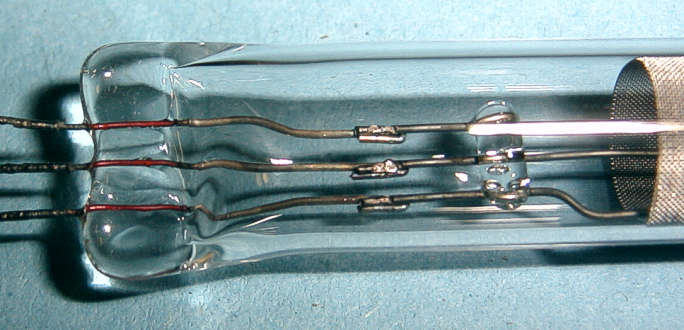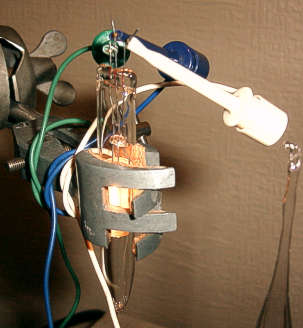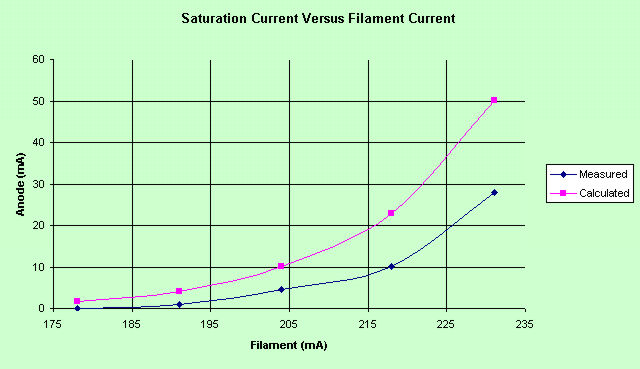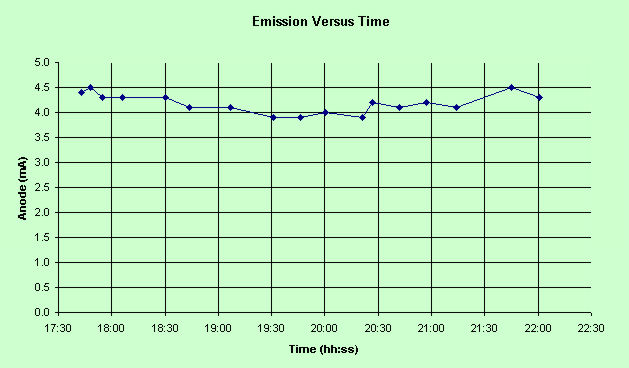

| Previous Page | Glass Blowing Menu | Main Menu | Next Page |
|---|
I made a second diode which I designated TD2. This version has two enhancements over TD1. The neck of the pump stem was drawn down to 3mm diameter to reduce the likelihood of cracking after seal-off. Also, Dumet wire was used for the glass to metal seals. This wire was recovered from failed standard light bulbs. Before seal-off, the filament was flashed at 245mA for 3 minutes with the anode power at 6.4W. TD2 was then sealed-off. The completed diode is shown below.

The glass to metal seals and filament support structure can be seen more clearly in the next picture.

The red Dumet seals can be seen quite clearly in the above picture. These second-hand seal wires were spot-welded to a Ni/Fe wire support structure which was made in the same way as for TD1. The external portions of the Dumet wires were oxidized very heavily by the flame used in the sealing process.
 This is TD2 after detachment from the pump. The pump side of the stem can be seen in the
right of the picture. The diode is held vertically in a clamp-stand to help to reduce droop
of the filament which could lead to a short-circuit between anode and cathode. The
filament can be seen glowing through the stainless steel anode mesh.
This is TD2 after detachment from the pump. The pump side of the stem can be seen in the
right of the picture. The diode is held vertically in a clamp-stand to help to reduce droop
of the filament which could lead to a short-circuit between anode and cathode. The
filament can be seen glowing through the stainless steel anode mesh.
Making reliable connections to the heavily oxidized Dumet wires was not easy. Silver loaded
paint was applied to the wires to improve the integrity of the connections.
The electron emission for TD2 was inferior to TD1 before seal-off. Emission fell still further after seal-off. The saturation current after seal-off is shown below.

To see if the diode's performance was steadily declining, it was kept powered with a filament current of 204mA and anode voltage of 150V for a period of over 4 hours and current readings were taken periodically. The results are shown in the graph below. The first result was taken 45 minutes after TD2 was sealed-off. At first, emission appeared to be falling, but the trend did not continue and the variations are probably only due to variation in the filament current.

TD2 was then tested periodically over a period of 15 days. During this period, the emission current slowly improved until it was comparable to the performance on the pump just after flashing. The improvement occurred without the diode being powered between performance tests. The only explanation I can think of is that something is acting as a getter and improving the vacuum. I would be interested to hear from you if you have any theories. The final saturated emission current at 204mA filament current was 6.1mA.
As a final test, the leakage current was measured using a pico-ammeter with an anode voltage at 150V and zero filament current. The leakage was found to be 3x10-11A.
| Previous Page | Glass Blowing Menu | Main Menu | Next Page |
|---|